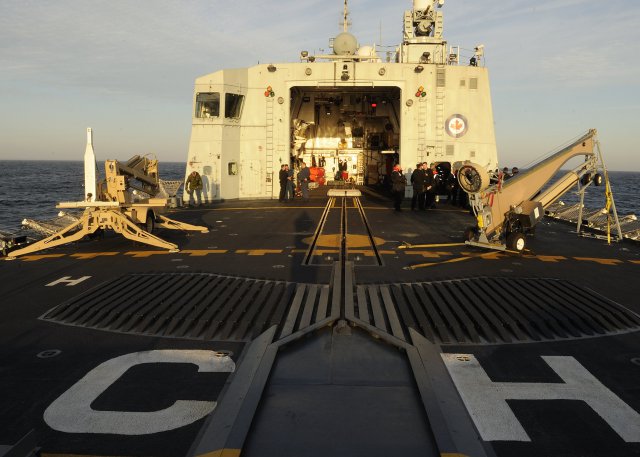
Aboard HMCS Charlottetown, the ship’s team and civilian technicians from ING Engineering place the launch and recovery equipment for the ScanEagle on the flight deck: the catapult launcher on the starboard side, and the recovery system — a device based on the Insitu SkyHook — on the port side - Photo : MCpl Robin Mugridge
When HMCS Charlottetown deployed to the Mediterranean Sea for Operation ACTIVE ENDEAVOUR, she took with her a potent surveillance and reconnaissance capability that is new to Canadian warships: the ScanEagle unmanned aircraft, a small, low-cost, long-endurance UAS built by Insitu, a subsidiary of Boeing.
Among her many tasks during this deployment, Charlottetown is exploring the feasibility of integrating UAS aboard HMC ships and developing expertise in operating UAS at sea.
HMCS Charlottetown will use the ScanEagle for general maritime surveillance in international waters and airspace.
“The ScanEagle was originally designed for fishing vessels to search for and locate schools of fish,” said Sergeant Michael Jenkins, leader of the UAS detachment embarked in HMCS Charlottetown. A member of 4 Air Defence Regiment, Royal Canadian Artillery, Sgt Jenkins has worked with the ScanEagle since 2008, when he deployed to Afghanistan with the UAS detachment supporting Canadian combat operations in Kandahar Province.
The ScanEagle team also includes civilian technicians, employees of ING Engineering, a Canadian business that delivers unmanned systems tailored to the needs of clients around the world.
“It is an excellent piece of kit that will provide my team with increased safety, which is a priority,” said Lieutenant (RCN) Adam MacIntyre, the Naval Boarding Party Officer on Charlottetown. “The overall picture of the situation will be up to date. I can liaise with the ScanEagle detachment to see what I want, when I want, through the video display. The more information I get that is accurate and relevant, the better.”
“[The UAS] allows us to see in the dark much further for longer periods of time,” added Commander Wade Carter, Commanding Officer of HMCS Charlottetown. “Back in World War I, in the Battle of Jutland, two gigantic battle fleets sailed past each other in the dead of night. The challenge has always been locating the enemy before he locates you. ScanEagle gives us a definite edge in this area.”
“Confirmation of the enemy, his intent and his location, without him even knowing it,” said Cdr Carter, summarizing what a UAS could bring to operations at sea. “ScanEagle is a game-changer in terms of rapidly developing situational awareness with low risk.”
The ScanEagle has been in service with the U.S. Navy since 2005. The most famous case in which it has been used to date was the April 2009 rescue by the USS Bainbridge of Captain Richard Phillips, master of the cargo vessel MV Maersk Albama, who was taken hostage by pirates.
